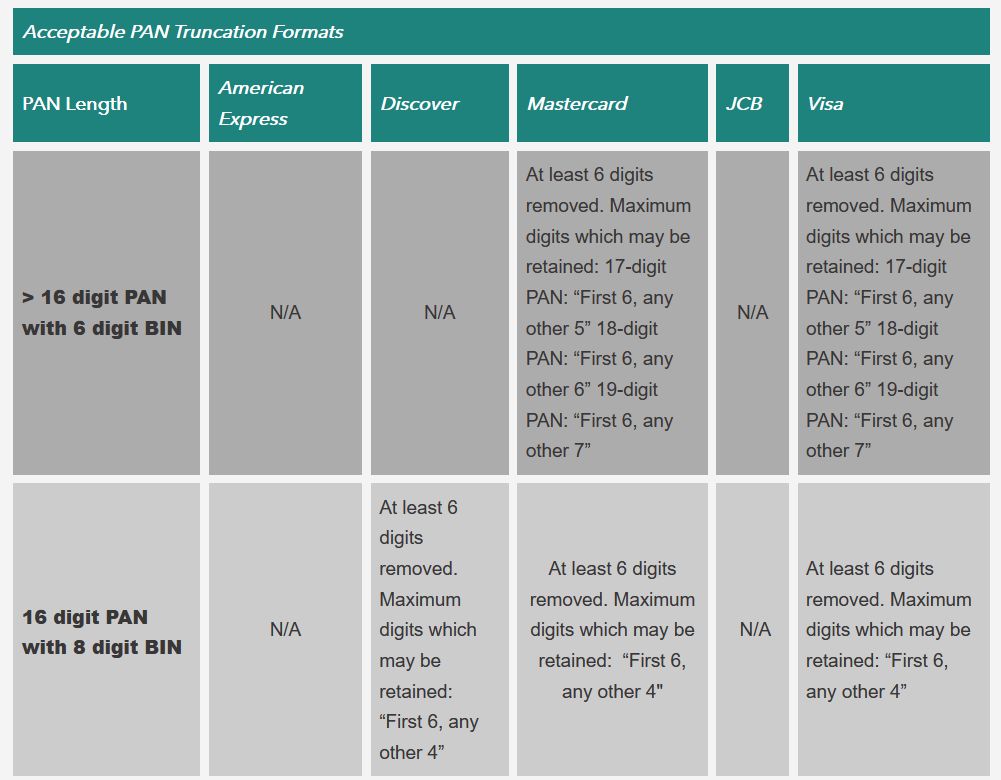PCI Compliance and the Intel AMT Vulnerability
On May 1st a critical new and possibly unprecedented vulnerability was announced. The flaw in...
2 min read
 David Gamey
:
Oct 10, 2017 10:07:00 PM
David Gamey
:
Oct 10, 2017 10:07:00 PM

Last month we wrote this article about issues arising from the addition of new BIN ranges and the lack of clear guidance specifically with 16-digit PAN that have 8-digit BINs. Today, the PCI Council just updated FAQ#1091 "What are acceptable formats for truncation of primary account numbers?" to specifically address the issue of how to truncate 16-digit PAN with 8-digit BIN. The short answer is that PCI's first six and last 4 truncation rule applies (see below) . But, and there is a but here, not all of the issues we identified will go away.

This clarification on acceptable truncation is very welcome as it provides stability to the payments ecosystem. However, organizations will still need to understand the impact of these changes on their payment systems. Guidance from the brands is also clear that relying on truncation alone will not be sufficient to protect the data if more digits are kept.
Lastly, we urge caution if you are using 6&4 truncation when these new PAN/BIN ranges go live. Specifically, we recommend that you monitor the risk of correlating truncated data to PAN considering both internal and external factors. Why? Because, we believe there may be additional risk here depending on how the Card Brands and Issuers allocate these BIN ranges. And while these are primarily risk questions for those organizations, you should also be aware of the risk. If you can live with more aggressively truncated PAN that will help to address this risk.
For example, consider the following approach which assumes an attacker can get 6&4 truncated PAN from your organization and a separate list of 8-digit BINs that are allocated and/or in use. The correlation risk will depend on how many of these BIN ranges match in the first six digits. If the BIN ranges are sparsely allocated there will be fewer 8-digit BINs with the same first 6-digits and correlation will be much easier than if the 6-digit ranges are densely allocated. Using fictitious examples from the previous article to bound the risk:
| PAN | Rule | Truncation | Strength | Compliance |
|---|---|---|---|---|
| 9234567890123455 | 6-4/16 | 923456xxxxxx3455 | 1 : 100,000 | PCI 3.2 |
| 9234567890123455 | 8-4/16 | 92345678xxxx3455 | 1 : 1,000 | Not PCI 3.2 compliant |
As you can see, depending on how sparsely the 8-digit BINs beginning 923456 are allocated, the strength will vary considerably. It is also clear, that anything less than full allocation reduces the strength.
| Number of BINs in 923456xx | Strength |
|---|---|
| 100 | 1 : 100,000 |
| 50 | 1 : 50,000 |
| 25 | 1 : 25,000 |
| 10 | 1 : 10,000 |
| 1 | 1 : 1,000 |
For a more detailed discussion of the issues please read our original article.

 David Gamey :
May 15, 2017 10:07:00 PM
David Gamey :
May 15, 2017 10:07:00 PM
On May 1st a critical new and possibly unprecedented vulnerability was announced. The flaw in...

 CG Blogger :
Nov 1, 2021 12:00:00 AM
CG Blogger :
Nov 1, 2021 12:00:00 AM
Control Gap is proud to introduce our participants for Movember 2021: Ben, Connor, Corey, and...

 David Gamey :
Dec 7, 2017 10:07:00 PM
David Gamey :
Dec 7, 2017 10:07:00 PM
PCI DSS is all about scope. Getting scope right or wrong is perhaps the single most critical factor...